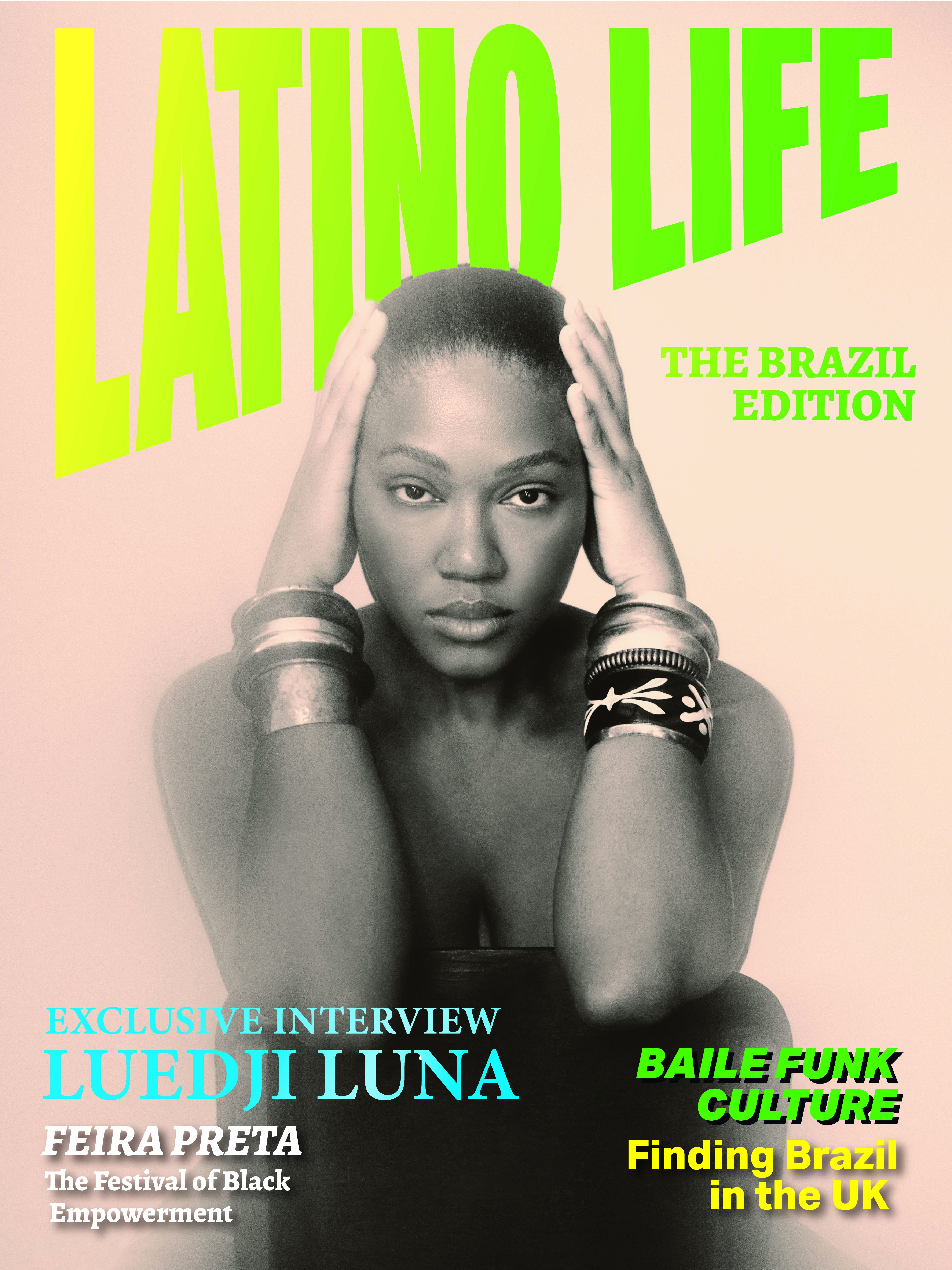It’s raining in Bogotá when Simón Mejía takes a few minutes to talk to Latinolife, but Mejía’s energy contrasts with both the dark, stormy afternoon in Bogotá and London’s usual night-time drizzle. He sounds excited:
“We’ve just finished the work on our fifth album 'Ayo' (just released) and are now rehearsing the tour. We spent most of this year concentrated on the album, so we’re really looking forward to playing it to audiences now.”
Bomba Estéreo – which according to Mejía, means "a really cool, awesome, bad ass party" - emerged in the 1990s as part of the new wave of ‘alternative’ Latin pop bands who added electronic beats to traditional popular folk. Some call their music ‘Cumbia for the 21st Century’, where Mejía’s innovative beats and loops and Liliana Sumet’s incendiary vocals set fire to an energetic fusion of Colombian roots and punk-psychedelia. The band had its detractors, but unlike some ‘alternative’ bands of that era which sounded pretentious amidst Colombia's sublime tradition of super musicians, Bomba Estéreo have, over the years, shown that their success is down to more than just style, albeit aided by some very useful fans such as Will Smith.
After a hugely succesful 2016, the Colombian band will spend the rest of 2017 in an extensive world tour alongside the release of the single 'Duele' which takes them to the US, Latin America and Europe, with two UK shows, headlining at the Bestival (East Lulworth, 10 Sept) and KOKO (London, 12 Sept). It’s been a long journey, admits Mejía:
“Before Bomba Estéreo I was doing electronic music but it was more like house, and I started to wonder what the point of it was when there were so many good people doing that in other places. So the mix with our Caribbean dance music like cumbia and champeta, was quite natural because both electronic and folkloric music were more connected that we’d thought. Since I started with it, the voice became a necessary ingredient because it gives spirit to the mix. And Li’s singing style worked perfectly, because her voice had a raw ingredient to it, which makes it unique: it brings all the traditional Colombian folklore into a urban context in a very energetic way.”
Since Saumet joined, the compositional work has been divided in the same way, with all the hits being the result of a recognisable collaboration. Mejía works on the beats, loops and bass lines, which he later sends over. Saumet then lets herself be inspired by the sound and creates lyrics and melodies accordingly.
Compared to previous albums ‘Ayo’ feels like a return home; more connected to the Colombia’s Caribbean roots which Bomba Estéreo’s music is mostly indebted to. The band is lucky enough to be able to draw on so many Latin rhythms such as salsa and rumba as well a huge resource within Colombia itself, which includes rythmns from the Pacific as well as the Caribbean still unknown to most musicians.
“Champeta is very interesting because it has a cadence similar to reggaetón. It originates from when the African soukous arrived in the Caribbean, in Barranquilla it took a specific form with a rhythm tum, dah, tum, dah…. quite full with guitars, synthesisers. It’s a music for dancing, super popular in barrios and streets, very Afro-Colombian”.
Mejía also admits that their ability to straddle continents has also benefitted the band’s evolution, incorporating the latest developments in electro, reggae, pop, rap as well as other music. The richness of influences can be heard on 'Ayo' more than in any previous.
“Because 'Ayo' was recorded in Santa Marta and Los Angeles, it has the energy of both those places. On the one hand it is linked to the land and our Caribbean roots and on the other, it has the electronic and very accomplished sound that is typical of L.A. studios,” Mejía explains.
Ayo comes after the success of Amanecer (2015) with such songs such as ‘Somos dos’, ‘Fiesta’ and the album itself being placed amongst the Rolling Stone’s list of the 50 best albums of 2015. Yet, Amanecer’s big bomb was last autumn’s single ‘Soy Yo’ (I Am Me), which went viral reaching 25 million views on Youtube. So great was the impact that President Obama invited the 11-year old Sarai Gonzalez who featured in the video to meet him in the White House. The ensuing covers in The New York Times, The Guardian and Vogue drew welcome attention to the band, if accidentally.
Ayo’s first single 'Duele' (Hurts), is the story of a truncated love which transpires Middle Eastern vibes although it was recorded with a flauta de millo, a flute from the Caribe region typically used by cumbia ensembles.
"The flauta de millo has been one of the most inspiring instruments in our career," Simon Mejia. "We've used it since ‘Estalla’. The sound is unique and beautiful with roots for the entire cumbia tradition. I remember once playing it for Brian Eno when I met him for a mentorship and he was like 'oh my god, I've never heard that kind of sound before in my life!'"
'Internacionales' (International) reiterates the message that most artists ars talking about these days – unity, oneness, harmony and diversity. ‘Mixed, we’re mixed, the same history with different taste’, says Saumet’s sweet voice before inviting everyone to share the dance.
“Liliana is very special in the way she writes and the things she says, and that has enabled us to make music which is to dance but also it invites you to listen, because the songs are saying specific things. Hopefully this album 'Ayo' will be received in the same way, because both sides to it are very important, in particular when so important things are happening in the world.
Bomba’s focus on lyrics may not make them superstars in an era where reggeaton pop is making huge inroads into the English speaking market, with less than sophisticated lyrics. But, as Mejia implies, Bomba Estereo have carved out their own niche international audience for whom, if ‘Despacito’ were never uttered again it would be too soon.
“I think Liliana in particular has a sensibility that is appealing in its own way. I do like reggeatón, but the lyrics are mostly chauvinistic and banal. Women have a special sensibility, or they access it more than us, and that is very powerful.”
Liliana has said that her lyrics have moved from the social to more introspective aspects as well…and Mejía agrees
“We’ve never wanted to be too discursive. Of course eventually we’ve said certain things, but didn’t want them to become part of our style or extremely political. I think we’ve learned in all these years of making music, recording, playing live and travel that you lose control of the music you make once it’s out and we need to be very conscious of that because when we put too much ego into it that’s when magic gets lost. You share an energy with your audience and you need to take care of that and to take responsibility for that as well.”
Now embarking on a new project, 'Monte', Simón has released its second single "Jungla."
"Jungla is a journey through a river in the middle of the Colombian jungle," Simon explains. "The sunset falls and the sound of the insects and birds starts to fill the environment, until it becomes a mass of deafening frequencies. Night falls and everything goes to sleep."
The video, directed by Simón Hernandez, is a translation of this nature journey into the city. Nostalgia, hidden memories and the void of the uninhabited spaces. It makes part of a dystopian trilogy about man and nature. In the "Mirla" video, the bird flew into a city, the city where "Jungla" occurs. "Jungla" ends up where the next video will begin.
Monte is an ambient electronic project in which Simon furthers his exploration of Colombian nature sounds. The project was announced with the album's title track 'Mirla.'
"For many years I've been planning to make an album of my own, so I got a really good microphone, a small one to put on my phone," he says. "Every time I went on a trip in Colombia, to the jungles of the Amazon or along the Magdalena River, I started recording."
Following extensive travel and research, Simón worked to interpret the nature sounds into an electronic music language - which animals sound like a high hat, which ones sound like bass drums and which ones sing the melodies.
What Simón found was not only the subconscious roots of Bomba Estéreo's visceral, earth-based energy, but a surprising connection between the tropical folk music he'd always embraced, and nature. It was always there, in the ambient murmurings featured on the 2009 album 'Blow-Up' to "Pajaros" (from 'Elegancia Tropical') to "Raíz" (from 'Amanecer'). Even Liliana Saumet's melody on Bomba's biggest hit, "To My Love" (750 million streams), was originally inspired by a bird call often heard on the Caribbean coast.
These were all precursors of the sound on his new seven-track album, 'Mirla.' "Mirla," at once the album's title track and its emotional center, is based on an actual experience Simón had with a bird that visited his house every morning around daybreak. He began noticing that this particular bird's song stood out from the rest, and meticulously recorded its songs. "Every day he came closer to my terrace, and—this is crazy—I could feel that he was watching me recording him and as a result started singing even better," he explained.
But one day, Simón woke up to the sound of something crashing into his window—the bird he had been recording was killed by the impact. "I don't know why it happened," Simón says, "but I buried him and made this kind of ritual, I was crying and everything." "Mirla" has a kind of solemn but hopeful bounce to it, using a graceful interplay between the charango, a stringed folk instrument, light percussion, a swarm of synths, and the birdsong itself.
Simón has big plans to expand the concept behind 'Mirla,' but at the same time is committed to future Bomba Estéreo projects, including a new album in its finishing stages. 'Mirla' is emblematic of work he's been doing as a documentarian, a film will be released later this year in collaboration with the environmental organization Stand for Trees.
With 'Mirla' and future works, Simón is hoping he can play an important role in moving our relationship with the environment in a more positive direction. "We're separated from nature and that's why all the environmental change is happening today, because we lost that connection," Simón says. "I think music, and sound, can be a way to re-establish that connection again, and make people feel that we are part of nature, and we are dependent on nature, and that nature is dependent on us."



















